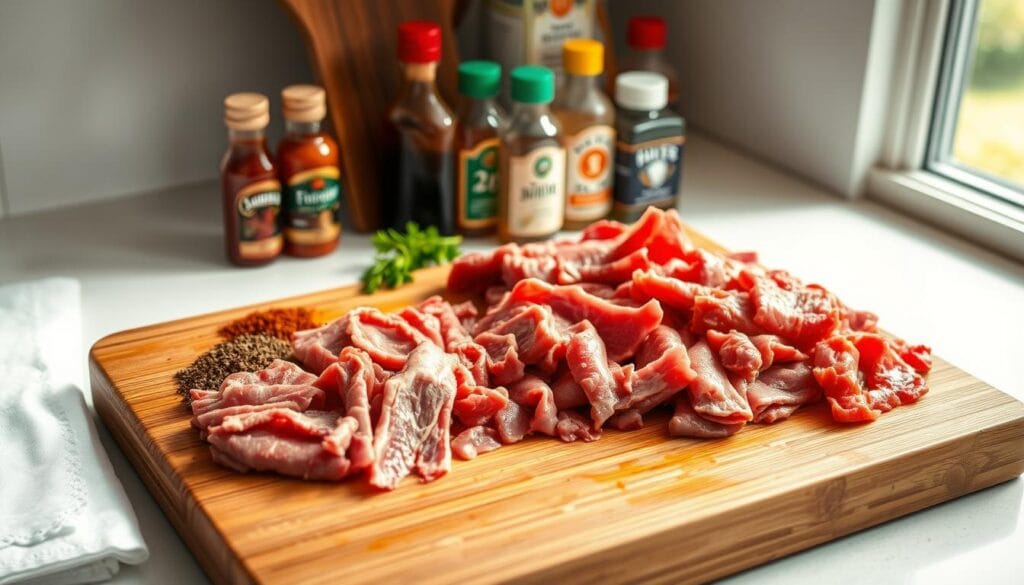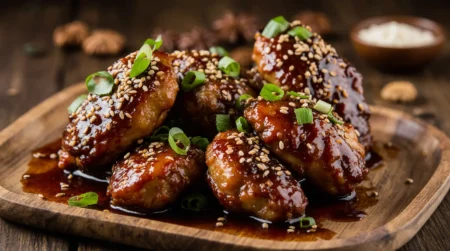Ever wanted to make that amazing Mongolian beef like the restaurants but felt it was too hard? You’re not alone. Watching a chef make it effortlessly was mesmerizing to me.
It’s actually easy to make authentic Mongolian beef at home. With the right ingredients and techniques, you can get that rich, tangy taste. This guide will show you how, making you a pro at home cooking.
Whether you’re new to cooking or have been doing it for years, this recipe is a must-try. It’s your new comfort food. Impress your loved ones with flavors from your kitchen.
Table of Contents
Key Takeaways
- Master the authentic Mongolian beef recipe with simple techniques
- Learn professional cooking tips for perfect flavor and texture
- Discover how to recreate restaurant-quality dishes at home
- Understand the key ingredients that make Mongolian beef special
- Boost your confidence in preparing Asian-inspired cuisine
What Makes Authentic Mongolian Beef Special
Mongolian beef is a favorite in Chinese-American cuisine. It’s loved for its rich flavors and unique cooking. This dish is more than just a recipe.
The story of Mongolian beef is interesting. It combines old traditions with new ideas. But, it didn’t come from Mongolia. Instead, it started in American Chinese restaurants.
Origins and Cultural Significance
Mongolian beef was created in the 1970s in San Francisco. Chefs made it for American tastes. They mixed flavors to make a dish that’s now a classic.
- Developed in American Chinese restaurants
- Designed to suit Western taste preferences
- Became a best-selling menu item nationwide
Traditional vs Modern Preparations
Mongolian beef has changed over time. Old recipes used simple ingredients. Now, restaurants add more flavors and techniques.
Key Flavor Profiles
The flavors in Mongolian beef are what make it special. It has sweet, savory, and spicy notes. Soy sauce, brown sugar, and garlic make a delicious sauce for the beef.
- Sweet undertones from brown sugar
- Savory depth from soy sauce
- Subtle heat from chili peppers
The best Mongolian beef recipes balance these flavors. They turn a simple dish into a favorite in the U.S.
Essential Ingredients for Restaurant-Style Mongolian Beef
Starting an authentic Mongolian beef recipe means picking the right ingredients. Your journey begins with choosing top-quality parts that capture the dish’s essence.
The secret to Mongolian beef’s taste is in the meat and seasonings. Focus on ingredients that highlight the dish’s rich, complex flavors.
Primary Ingredients for Mongolian Beef
- Beef Cut: Flank steak or sirloin (thinly sliced)
- Soy sauce (preferably low-sodium)
- Brown sugar
- Garlic (fresh, minced)
- Ginger (fresh, grated)
Choosing the right ingredients is crucial for Mongolian beef. Professional chefs know quality is key in every part.
Sauce Ingredients Breakdown
| Ingredient | Purpose | Recommended Quantity |
|---|---|---|
| Soy Sauce | Primary Flavor Base | 1/2 cup |
| Rice Wine | Depth and Complexity | 2 tablespoons |
| Brown Sugar | Sweetness Balance | 1/4 cup |
When making Mongolian beef, think about substituting ingredients if needed. You can still get authentic flavors with alternatives that match the original.
Pro Tip for Ingredient Selection
Always pick fresh ingredients. The quality of your Mongolian beef depends on the freshness and authenticity of your parts. Choose high-grade beef and fresh garlic to make your recipe better.
Kitchen Tools and Equipment You’ll Need
To make authentic Mongolian beef, you need the right tools. The right equipment makes cooking easier and more fun. Whether you’re cooking at home or dreaming of being a chef, the right utensils are key to making great Mongolian beef.
For Mongolian beef, you’ll need some essential tools. These tools will make your cooking better and more fun.
Must-Have Utensils for Mongolian Beef
- Sharp Chef’s Knife: Critical for precise meat slicing
- Cutting Board
- Meat Tenderizer
- Measuring Cups and Spoons
- Large Mixing Bowl
Optional but Helpful Cooking Tools
- Digital Meat Thermometer
- Kitchen Tongs
- Slicing Board with Juice Groove
- Marinade Injector
Wok vs Regular Pan: Choosing Your Cooking Surface
Your cooking surface is key for Mongolian beef. A wok is best because it distributes heat well and is great for stir-frying. But, if you don’t have a wok, a regular pan works too.
| Wok | Regular Pan |
|---|---|
| Better heat distribution | More common in home kitchens |
| Authentic stir-fry technique | Easier to handle |
| Requires special care | Less expensive |
For making great Mongolian beef, choose sharp, quality tools. Knowing your cooking surface helps too. The right tools can make your dishes taste like they’re from a restaurant.
Preparing Your Beef for Perfect Results

Making a great Mongolian beef recipe begins with picking the right meat. How you prepare the beef can greatly affect its taste and texture. It’s what makes your dish stand out.
For tender Mongolian beef, go for flank steak or sirloin. These cuts have the right mix of lean meat and fat. This mix makes the beef incredibly tasty.
Beef Cutting Techniques
- Slice beef against the grain for maximum tenderness
- Cut into thin, uniform strips (approximately 1/4 inch thick)
- Use a sharp knife for clean, precise cuts
Marinating Secrets
Marinating turns regular beef into a flavorful Mongolian beef dish. A good marinade can take your recipe from good to amazing.
| Ingredient | Purpose | Quantity |
|---|---|---|
| Soy Sauce | Tenderizes and adds umami | 3 tablespoons |
| Cornstarch | Creates crispy exterior | 1 tablespoon |
| Rice Wine | Adds depth of flavor | 2 tablespoons |
Pro tip: Let your beef marinate for 15-30 minutes to maximize flavor absorption and tenderness.
Learning these Mongolian beef preparation tips will make your homemade dish as good as any restaurant’s. The secret is patience, precision, and knowing how each step adds to the dish.
Mastering the Mongolian Beef Sauce
Making the perfect sauce is crucial for a great Mongolian beef dish. The right sauce turns simple ingredients into a dish that wows everyone. It’s all about finding the right balance of flavors.
Base Sauce Components
A classic Mongolian beef sauce needs a few key ingredients. These ingredients create a rich and complex flavor:
- Soy sauce for umami depth
- Brown sugar for sweetness
- Garlic and ginger for aromatic warmth
- Cornstarch for thickening
- Rice vinegar for tangy brightness
Balancing Sweet and Savory
The secret to a great sauce is finding the perfect balance. Start with equal parts soy sauce and brown sugar. Then, adjust to taste. A pinch of red pepper flakes adds a nice heat that balances the sweetness.
Adjusting Thickness and Consistency
Getting the sauce consistency right is key. Cornstarch helps make a glossy, clingy sauce. Mix cornstarch with cold water before adding to avoid lumps. For a thinner sauce, add water. For thicker, add more cornstarch.
Pro tip: Always whisk your cornstarch mixture thoroughly to ensure a smooth, velvety sauce that clings perfectly to your beef.
Step-by-Step Cooking Instructions
Making Mongolian beef at home is simpler than you think. This recipe turns basic ingredients into a dish that will wow your loved ones.
Begin by preparing your beef. Pick a top-quality cut like flank steak or sirloin. Cut the meat into thin strips, about 1/4 inch thick. This makes the beef tender and easy to eat.
- Thinly slice 1 pound of beef
- Pat meat dry with paper towels
- Dust beef with cornstarch
- Season with salt and pepper
To stir-fry like a pro, heat your wok or large skillet until it’s smoking hot. Use a high-smoke-point oil like vegetable or peanut oil. Quick, high-heat cooking is key to authentic Mongolian beef.
“The secret is in the sear – quick and hot is the way to go!” – Professional Chef
Cooking times are important. Stir-fry the beef in small batches, cooking each batch for about 2-3 minutes. This will give it a golden-brown crust. Remove the meat and set it aside while you make the Mongolian beef sauce.
- Cook in small batches
- Avoid overcrowding the pan
- Aim for golden-brown edges
- Keep meat tender by not overcooking
When you add the beef back to the sauce, do it quickly. Toss the meat to coat it evenly, warming it through for 30-60 seconds. This keeps your Mongolian beef juicy and full of flavor.
Secret Tips for Authentic Restaurant Flavor
To make your Mongolian beef taste like it’s from a restaurant, you need more than a recipe. Chefs use special techniques to make this dish truly stand out.
For restaurant-quality Mongolian beef, you need precision and insider tips. These secrets will help you cook this dish like a pro.
Professional Chef Techniques for Perfect Beef
- Slice beef against the grain for maximum tenderness
- Use cornstarch coating to create a crispy exterior
- Briefly marinate meat for deeper flavor absorption
Mastering Temperature Control
Temperature is key to making authentic Mongolian beef. Chefs know that high heat is needed for that perfect sear.
| Cooking Stage | Recommended Temperature | Cooking Time |
|---|---|---|
| Beef Searing | High (400-450°F) | 1-2 minutes |
| Sauce Reduction | Medium-High (350-375°F) | 2-3 minutes |
Timing and Coordination Secrets
The secret to great Mongolian beef is timing. Prepare everything ahead of time and cook fast to keep flavors and textures perfect.
“Speed and precision are the hallmarks of great restaurant cooking” – Professional Chef Technique
With these chef tips, your Mongolian beef will go from a simple meal to a dish that wows everyone.
Common Mistakes to Avoid

Perfecting Mongolian beef means avoiding common mistakes. These errors can ruin the flavor and texture of your dish. By knowing these tips, you can make delicious Mongolian beef at home.
- Meat Selection Errors: Pick the right cut of beef. Flank steak or sirloin are best. Avoid tough or fatty cuts that won’t crisp well.
- Slicing Technique: Cut meat against the grain in thin, even slices. Uneven thickness can make the meat tough and cook unevenly.
- Marinating Mistakes: Don’t rush the marinating. Let your beef marinate for at least 30 minutes to soak up flavors and get tender.
Preparing the sauce is key when making Mongolian beef. Many struggle to get the flavors just right.
| Common Mistake | Solution |
|---|---|
| Watery Sauce | Use cornstarch to thicken and create a glossy coating |
| Oversalting | Measure soy sauce carefully and taste as you go |
| Burning Sauce | Cook on medium-high heat and stir constantly |
Getting the cooking temperature right is crucial for delicious Mongolian beef. High heat gives a crispy outside and a tender inside. Stir-frying quickly keeps the meat juicy.
- Avoid overcrowding the pan
- Cook in batches if necessary
- Use a wok or large skillet for best results
By following these tips and avoiding common mistakes, you’ll master Mongolian beef at home. Remember, practice and patience are essential to impress your loved ones.
Perfect Side Dish Pairings
Improving your Mongolian beef recipe is more than just the main dish. The right sides can make your meal unforgettable. They add balance and make your meal memorable. Whether you’re making an authentic or modern version, picking the right sides is key.
Choosing the best sides means knowing what flavors and textures work well together. Your Mongolian beef’s rich sauce needs sides that balance its strong taste.
Traditional Accompaniments
Classic sides for Mongolian beef are simple and clean. They don’t fight with the dish’s bold flavor. These sides make a meal that’s in perfect harmony:
- Steamed white rice
- Jasmine rice
- Plain fried rice
- Stir-fried vegetables
Modern Fusion Options
If you want to try something new, modern sides can add a twist to your Mongolian beef:
- Cauliflower rice
- Quinoa pilaf
- Roasted sweet potato
- Asian slaw
| Side Dish Category | Recommended Pairing | Flavor Profile |
|---|---|---|
| Traditional | Steamed White Rice | Neutral, absorbs sauce |
| Modern | Cauliflower Rice | Light, low-carb alternative |
| Vegetable | Stir-Fried Bok Choy | Fresh, slightly crisp |
When picking sides for your Mongolian beef, think about texture, flavor, and nutrition. You want a meal that tastes great and fills you up.
Storage and Reheating Guidelines
Keeping your homemade Mongolian beef fresh is key. Use the right storage and reheating methods. This way, your meal will taste as good as when you first made it.
Refrigeration Best Practices
For storing Mongolian beef, pick airtight containers. Cool it down first to stop bacteria from growing. Your dish will stay fresh for 3-4 days if stored right.
- Use glass or BPA-free plastic containers
- Separate sauce from meat if possible
- Store in shallow containers for quick cooling
Freezing Techniques
Freezing is a great way to keep your Mongolian beef longer. Wrap it tightly in containers or bags to avoid freezer burn.
| Storage Method | Maximum Storage Time | Quality Preservation |
|---|---|---|
| Refrigerator | 3-4 days | Good |
| Freezer | 2-3 months | Excellent |
Reheating Tips
Here’s how to reheat your Mongolian beef. The goal is to warm it up gently. This keeps the meat tender and the sauce flavorful.
- Microwave: Use medium power, stir every 30 seconds
- Skillet: Reheat on low heat with a splash of water
- Oven: Cover with foil, warm at 350°F for 10-15 minutes
Pro tip: Always check the internal temperature reaches 165°F to ensure food safety when reheating your Mongolian beef.
Healthy Modifications and Substitutions
Making your Mongolian beef recipe healthier doesn’t mean losing flavor. Smart swaps and cooking tricks can make this classic dish fit many diets. It keeps the taste delicious.
Changing your Mongolian beef recipe for different diets is simple. Here are some tips to make the dish:
Lower-Sodium Alternatives
- Replace traditional soy sauce with low-sodium soy sauce or coconut aminos
- Use fresh herbs and spices to enhance flavor without adding salt
- Choose reduced-sodium beef broth for sauce preparation
Dietary Restriction Options
For specific diets or food sensitivities, these Mongolian beef changes can help:
- Gluten-Free Version
- Substitute regular soy sauce with tamari
- Use cornstarch or arrowroot powder for thickening
- Verify all sauce ingredients are certified gluten-free
- Low-Carb Adaptation
- Replace sugar with monk fruit sweetener
- Serve over cauliflower rice instead of traditional rice
- Use lettuce wraps as an alternative serving option
- Vegetarian Alternative
- Swap beef with firm tofu or seitan
- Use mushroom-based protein for similar texture
- Maintain original sauce recipe for authentic flavor
The secret to a great Mongolian beef recipe is balancing flavors and respecting diets. Try these changes to make a dish that everyone can love.
Conclusion
Now you can make the best Mongolian beef at home. This guide shows you how to turn your kitchen into a pro cooking space. Follow the easy steps and expert tips to make a dish that wows everyone.
Getting good at Mongolian beef takes practice and love. Every time you cook it, you get better and understand the flavors more. Remember, cooking is all about learning and getting better with each try.
Your cooking journey doesn’t stop here. Try new ingredients, change the seasonings, and make it your own. Share your Mongolian beef with friends and family. The fun of cooking is in being creative and making memories.
This Mongolian beef recipe is for everyone, whether you’re experienced or new to cooking. Just enjoy the process, trust yourself, and love the tasty results of your cooking adventures.




